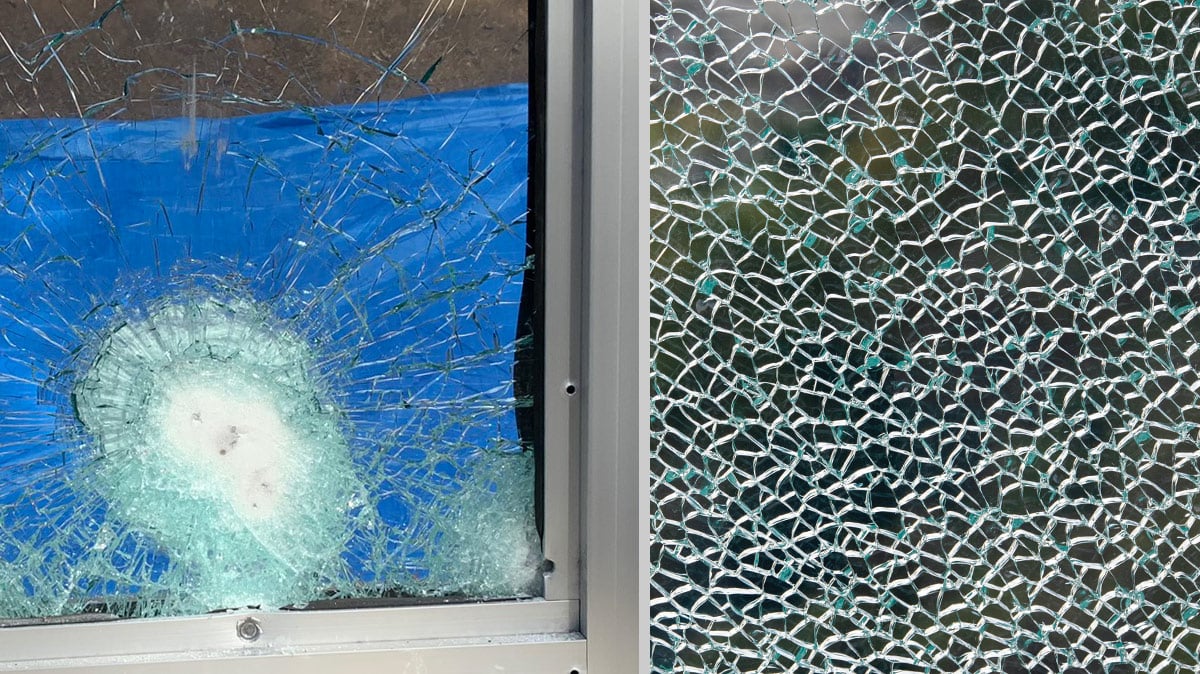Unbreakable window glass (also known as shatterproof glass) is proclaimed to be the original bulletproof glass. It gets its reputation as “unbreakable” due to the unique way it crumbles upon impact, collapsing into small, harmless pebbles instead of sharp, cutting pieces. Today, this type of laminated glass pales in comparison when tested against modern ballistic glass (meaning: glass that can stand up to a speeding projectile). In short: ballistic glass will stop a bullet, and unbreakable glass will not.
What is Shatterproof Glass?
Shatterproof glass is created by pressing a layer of resin in between two pieces of glass (a process referred to as lamination). The resin will continue to hold the layers of glass together, even when met with extreme force, resulting in the break-proof glass phenomenon. After being struck by a projectile, a shatterproof window will crumble into dull pebbles resembling a spider web like pattern instead of dangerous shards.

This is a critical difference from other glazing types. When tempered glass shatters, it breaks into small, blunt fragments that can still pose a risk. Standard glass windows tend to break into sharp, jagged pieces that can cause severe injury.
“These days, shatterproof glass is an alternative product for people who aren’t facing a ballistic threat, but still need to keep people out and keep their window intact,” said Total Security Solutions CEO Jim Richards. While unbreakable glass windows won’t stop a bullet, their ability to resist shattering may be the difference between life and death for a bystander during a violent impact or weather event.
Shatter-Resistant Glass Uses
The unique properties of unbreakable glass allow it to act as a strong deterrent against theft and forced entry attempts, protecting both your physical property and employees from harm. This type of security glass is most often installed in place of normal glass windows or doors in spaces such as commercial buildings, storefronts, and similar high-traffic areas that may be at risk of suffering from an extreme weather event or criminal attack.
Retail storefronts in high-traffic urban areas often rely on laminated glass windows to deter smash-and-grab attempts, slowing down intruders long enough to trigger alarms or intervention. Meanwhile, office buildings with large glass facades use shatterproof glass to reduce the risk of flying glass during storms or accidental impacts.
While laminated security glass provides meaningful protection against blunt force and environmental hazards, it is not designed to stop bullets. For facilities facing elevated risks of gun violence or targeted attacks, ballistic glass is the clear choice.
The Ballistic Glass Difference
Ballistic glass delivers critical protection in high-risk environments by providing a powerful line of defense against active threats like armed break-ins, workplace violence, or stray bullets. Designed to stop or slow down projectiles, it protects both people and property during an attack—buying valuable time for law enforcement to respond and helping to prevent injury or loss of life.
.jpg?width=800&height=674&name=Panama-2025---Client-Level-8-Testing-3%20(1).jpg)
You’ll find ballistic glass used across a wide range of facilities, including banks, hospitals, government buildings, corporate headquarters, and schools. In each of these settings, it plays a vital role in deterring violence, enhancing psychological safety, and supporting a secure, day-to-day operating environment.
The benefits of ballistic glass extend beyond security as well. These advanced systems often deliver added noise reduction, creating quieter, more focused environments. Many ballistic glass options also contribute to energy efficiency, thanks to their multi-layered construction that improves insulation and reduces heat transfer compared to standard window systems.
Types of Ballistic Glass
Ballistic glass will always outperform unbreakable glass when faced with a speeding projectile – but not all ballistic glass is the same. There are eight levels of bullet resistance as established by the Underwriter’s Laboratory, and a piece of glass must be able to stop a certain number of shots from a specific weapon in order to pass each level.
Additionally, bullet-resistant glass is often not even glass at all. Common options include clear acrylic, glass-clad polycarbonate, and polycarbonate window systems. A polycarbonate window is especially popular in settings where both ballistic protection and forced-entry resistance are needed—thanks to its toughness, lightweight properties, and resilience under repeated impact.

Check out this guide to learn more about the levels of ballistic glass and its uses in different industries.
The Right Security Glass for Your Environment
When it comes to safety glazing, there’s no one-size-fits-all solution. Laminated glass windows and shatter-resistant security glass play an important role in modern building design and offer a meaningful upgrade over regular window glass.
No matter how strong it is though, shatterproof glass won’t stop a bullet. Only ballistic glass—rated and tested under rigorous UL 752 standards—can offer that level of protection. Whether you’re replacing glass panels in a public entryway, upgrading glass doors in a healthcare setting, or hardening critical areas inside a financial institution, ballistic protection is the ultimate safeguard.

At Total Security Solutions, we help you evaluate your current vulnerabilities and find the right level of protection for your space, whether that’s reinforcing existing glass or designing a fully customized ballistic system. We’re here to provide practical, experienced guidance, because safety shouldn’t be guesswork.
Ready to talk about the right glass for your facility? Contact our team.

